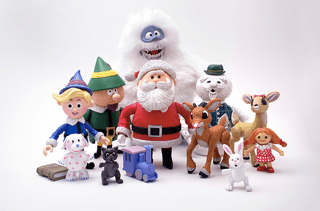By Laura Petrolino
How’d you like to be a spotted elephant?
Or a choo-choo with square wheels on your caboose!
Or a water pistol that shoots… jelly?
We Are All Misfits!
Growing up, I always had a weird fascination with the Island of Misfit Toys. In fact, I’m pretty sure I asked my parents if I could go there multiple times.
Being a “misfit” just seemed so much better than being ordinary.
I mean, come on—why would you want to be an ordinary elephant if you could be a SPOTTED elephant? (Unless of course you had chicken pox, or a rash, or something…that would be bad. We are just talking about “fashion spots” here.)
Anyone who knows me at all knows I’m all about embracing my uniqueness—my “special snowflake” pattern.
The misfit toys serve as an important reminder to do just that. They teach us it is not necessary to be like everyone else to provide value.
In fact, it is often in leveraging your difference where you really provide value.
A True Unique Value Proposition
In marketing, we throw around the term “Unique Value Proposition” often. Yet many times, despite our big talk about what makes us unique, a certain sense of fear prevents us from really defining ourselves clearly from our competitors.
We want to be unique and have a clear differentiation, but only in the ways it will affect our business positively.
Unfortunately, truly being unique requires you to accept the good with the bad.
For every customer that says, “Yes, this is exactly what we are looking for,” or, “This is what we’ve been missing,” there might be five others that say, “Whoa…I’m not so sure.”
Not necessarily because they don’t like what you do, or even because they don’t understand it.
Instead, it might be because just as it takes a certain fearlessness to embrace what makes you different, it takes that same courage from the consumer side.
To stand out from the crowd and invest in something that’s not the status quo, doesn’t fit the mold, or is simply unexpected—that takes a little bit of faith, a longer term vision, and a lot of trust.
Don’t Hide Your Spots
Our spotted elephant could very well simply try to hide his spots. He could try to fit in, so his difference didn’t distract people from his value, or maybe even only show them at certain times.
While this might serve his purpose, he is selling both himself and the people he could help short.
To really make your uniqueness work for you, you must embrace it, fully—all of the time.
Now, this doesn’t mean ignoring push back and apprehension from your consumer. It doesn’t mean just forging boldly (and blindly) ahead.
Instead, it means learning from that push back—finding a way to meet your audience where they are and escort them the rest of the way.
After all, even the most expert climbers need a guide to navigate Everest. Neither of you will reach the summit if you don’t ascend together.
How to Climb Mount Misfit
How then do you help your customer safely climb Misfit Mountain with you?
Just as Rudolph convinced Santa to let the misfit toys have their chance to shine, you win small victories.
Call it burden of proof, or ’tis the season so call it “guiding the sleigh” (i.e. “Rudolph with your nose so bright, won’t you guide my sleigh tonight,” SING IT WITH ME NOW), you lay the foundation of trust step by step, one small risk at a time.
That’s how a guide works, and you must be a guide for your consumer.
Going back to our Mount Everest analogy: Imagine if the guides just met everyone at the bottom, gave them a map and said “Ok, let’s go, meet you at the top.”
Not only would most people turn and run away, but the journey wouldn’t be all that successful.
Instead, they have the long-term vision and plan of where they are going to go, but they take it one trek at a time.
One small summit, one milestone each day until they reach the next. One small risk to accomplish and build confidence before the next push.
In this way success is a progression, not a destination.
Take the Rudolph Challenge
As we move into 2015, take the Rudolph challenge. Ask yourself not just what makes you different, but how you can bring your customer along with that difference.
How can you “guide the sleigh” so they aren’t just intrigued by what makes you different, they embrace it as a necessary part of their success?
